By: Mazvita Chikomo, Srushti Chaudhari, Fred Zhao (as part of the AMRE 2020; The College of Wooster, Tree Ring Lab)
The aim of this study was to analyze White oak trees, to see how old they are and, how they are responding to the wetter and warming climate in Wooster, OH.

Kinney Field, Wooster, OH.
Kinney Field, located in Wooster, OH has long served as a recreational location for various sports and a nice place for public entertainment. On its southwest corner are several old white oaks making it an ideal destination for tree-ring research. The geological setting is an Ice Age kame (hill) left by the retreating Laurentide Ice Sheet approximately 15,000 years ago. The hill on which the trees grow is thus a well-drained feature built of permeable sediments, likely sand and gravel. We set out to determine the age of the trees, build a tree-ring chronology from the ring-widths, and compare the ring-width series with the monthly meteorological observations recorded at Wooster’s OARDC since C.E. 1888. This helps us better understand how this important tree species is reacting to a changing climate.
Bottom line: Nineteen cores were taken from 11 trees and processed at The College of Wooster Tree Ring Lab. We found that the White Oaks (Quercus alba) growing in the Kinney Field are positively correlated with precipitation in the April, May, June, and July months and have a strong negative correlation with June temperature.
Methods: Nineteen 5-mm diameter tree cores from were collected from 11 trees (Table 1) and, combined to produce a ring-width tree-ring chronology (Figure 2) at the Kinney Fields site, in Wooster, OH (Figure 1). The samples were cross dated in The College of Wooster Tree Ring Laboratory (WTRL) and were measured to the nearest 0.001 mm. This was then statistically cross-dated using the COFECHA (Holmes, 1983) software, and the chronology was then standardized using the ARSTAN software (Cook et al. 1985). The final chronology is made up of 19 cores from 11 trees with a mean series intercorrelation of 0.66 and an average mean sensitivity of 0.24 (Table 2). We used the raw data for the final chronology and point out the upward increasing trend in the series (Figure 2).

Fig. 1: Map showing study site at Kinney Field, Wooster, OH.
The monthly temperature (1894 to 2019) and precipitation (1888 to 2019) for Wooster Ohio taken at the OARDC data was acquired from the Global Historical Climatology Network (GHCN). The mean annual temperature was 9.8ºC and the average annual precipitation was 947 mm during this time period. The months with the highest precipitation for 1888 to 2019 were June and July, and the highest temperature during the years 1894 to 2019 were June, July, and August. The months with the lowest temperatures were January and February (Figure 3).
 The team coring a White Oak.
The team coring a White Oak.
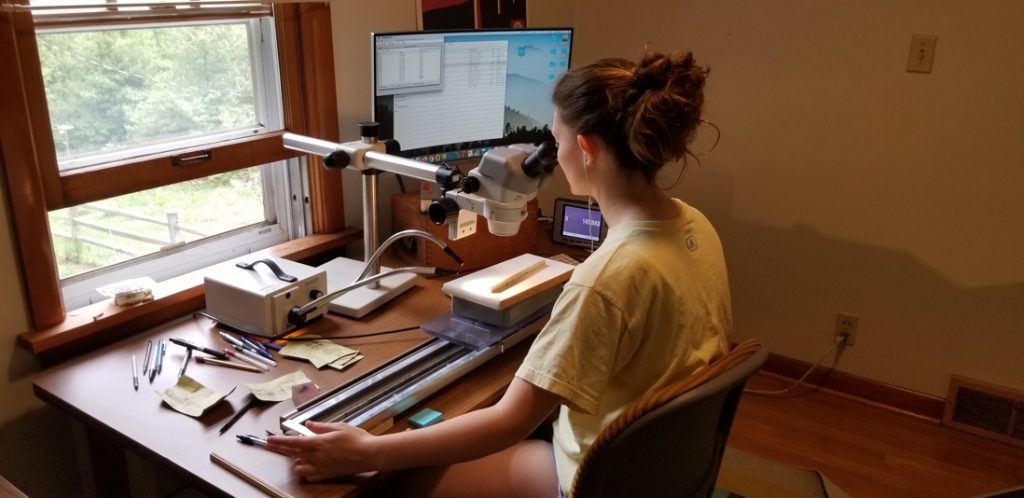 Measuring tree cores from Kinney Field in the Lab.
Measuring tree cores from Kinney Field in the Lab.

Fig. 2: The raw ring width series for the Oaks at Kinney Field, Wooster, OH.

Fig. 3: Climograph showing the annual distribution of precipitation (1888 to 2019) and mean monthly temperature (1894 to 2019) for Wooster.

Fig. 4: Raw ring-widths correlated with monthly temperature records. Only the month of June is significant at the 0.05 level (the common interval is 1895-2019).

Fig. 5: Raw ring-width series correlated with monthly precipitation (1888-2019). The months of April-July are significant (p<0.05) and positive correlations.

Fig. 6: April-July total precipitation correlated with the raw ring width series with a correlation 0.57.
Discussion: The final ring width chronology is 200 years long from 1820 to 2019. The series intercorrelation is 0.66 whereas the mean sensitivity (measure of year to year variability) is 0.24. The series autocorrelation is 0.60 and is a measure of the persistence as it is when the chronology is correlated with itself. The mean ring width measurement is 4.25 mm, which is significantly high relative to other sites and implies that the trees have proper access to nutrients and there is little competition. There is a strong positive correlation between the ring width and the precipitation in the months of April through July, and the trendlines for both closely follow each other throughout the chronology ( Figures 5, 6). Therefore, we can gather that the trees are tracking the low frequency increase (last ~100 year rise) in precipitation of the region and are also a good indicator of year to year April – July precipitation records in Wooster, OH. The correlation with monthly temperatures is only significantly negatively correlated with June temperature (Figure 4). The correlation with June is -0.35 (Figure 5) is likely attributed to the high rates of evapotranspiration in the summer months, which can have negative impact on tree growth.
Conclusions:
1. The Kinney oaks are all less than about 200 years old and are therefore likely second growth;
2. The raw ring-width data from 19 tree cores has an upward trend strongly correlated with total April through July precipitation measured at the OARDC since 1888;
3. The negative correlation of -0.35 of raw ring width and June temperature is due to increased evapotranspiration demand during warm Junes.
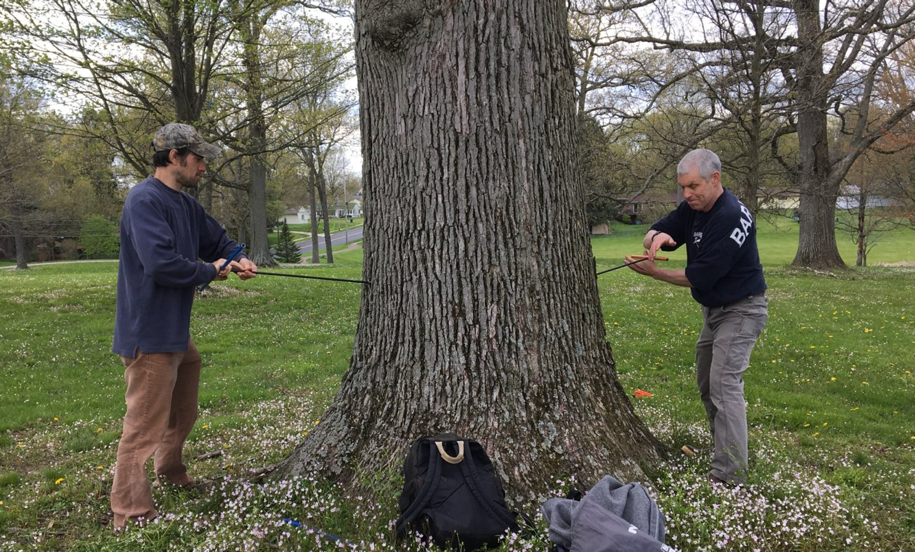 Co-directors Nick Wiesenberg and Dr. Greg Wiles.
Co-directors Nick Wiesenberg and Dr. Greg Wiles.
Acknowledgements:
This work is supported by the Sherman-Fairchild Foundation and the Luce Foundation. We also thank the organizers of AMRE 2020.

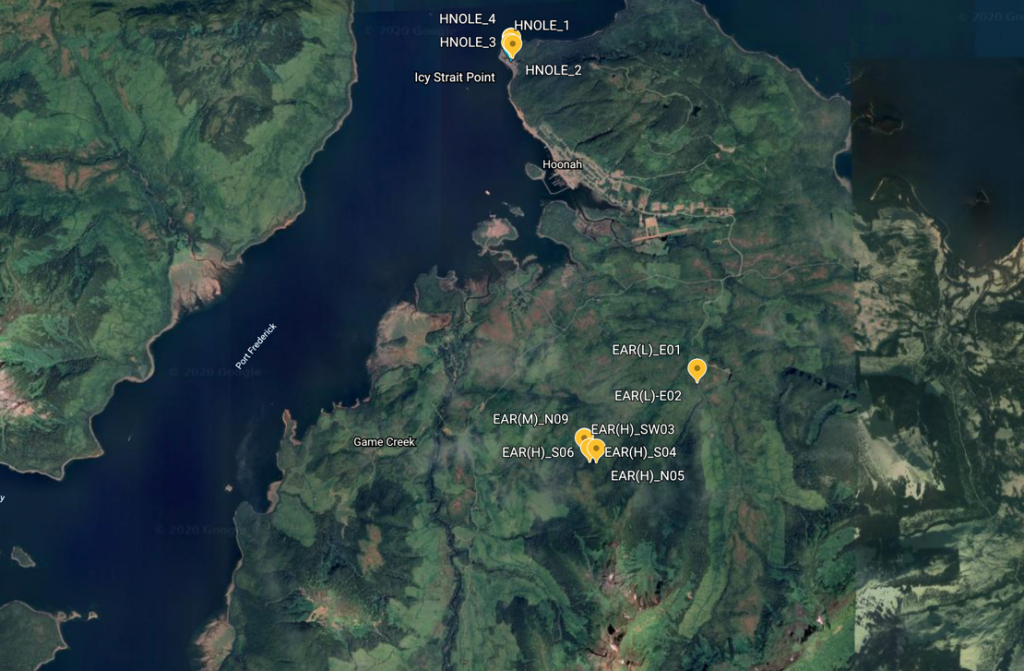
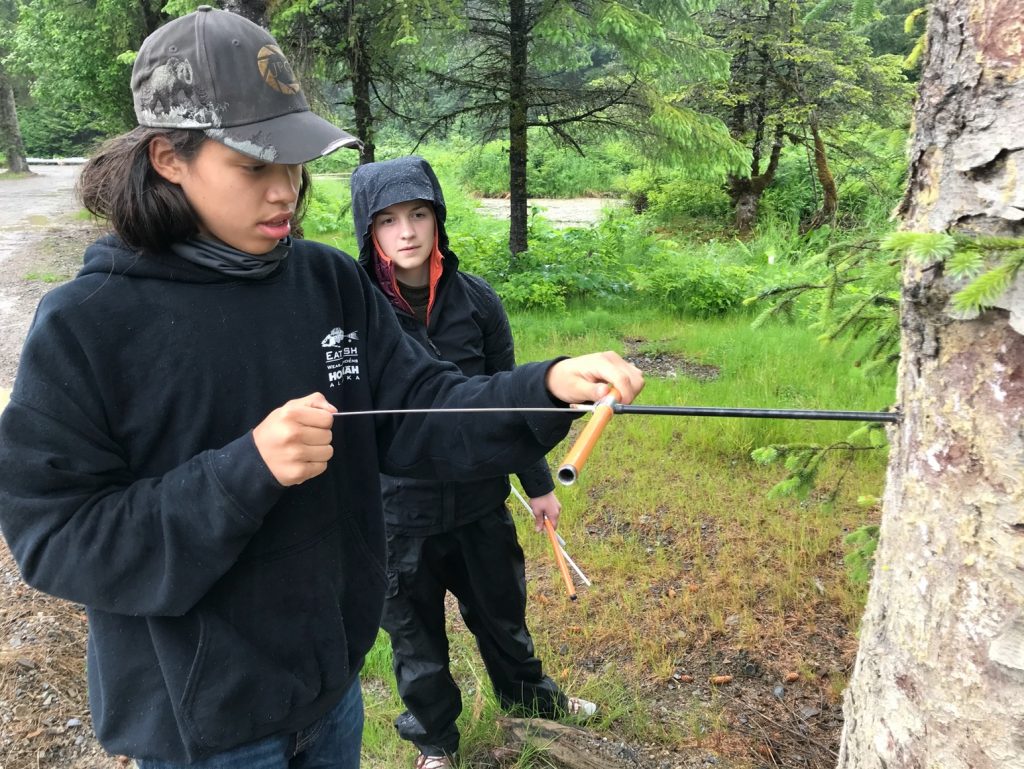 The group shown coring a Sika spruce just outside of town.
The group shown coring a Sika spruce just outside of town.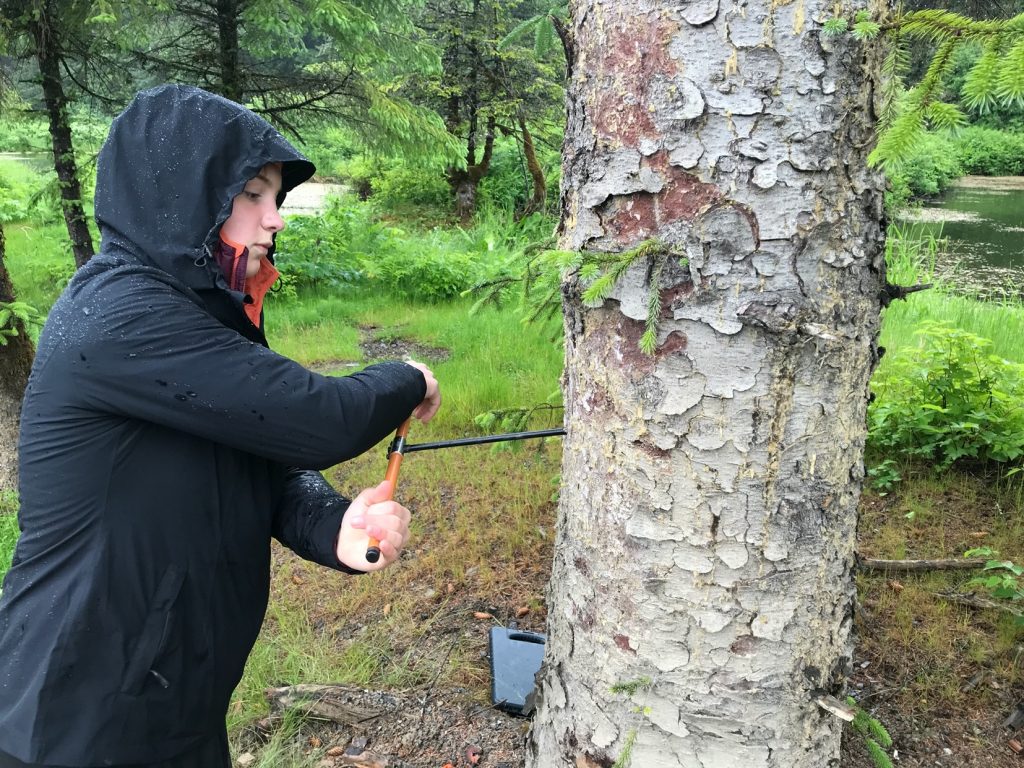 More coring – this time in the rain.
More coring – this time in the rain.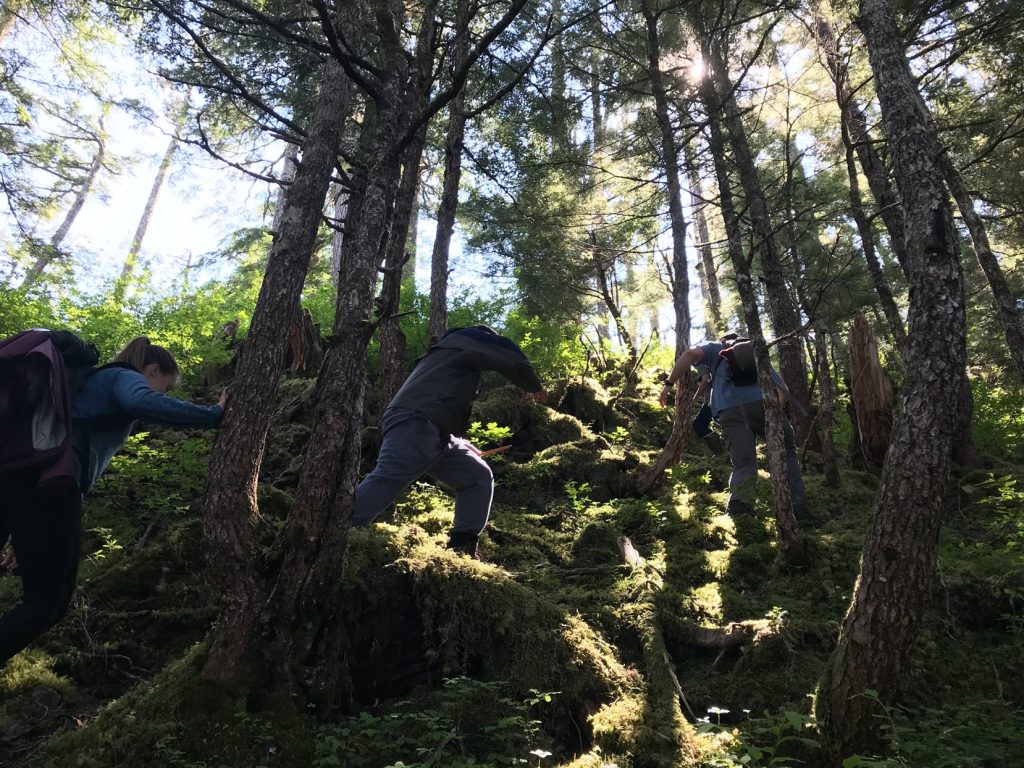 The steep climb up the flank of Ear Mountain to find the old Mountain Hemlocks.
The steep climb up the flank of Ear Mountain to find the old Mountain Hemlocks. Comparisons of the fast growing Sitka Spruce and the slow growth of the higher elevation Mountain Hemlock.
Comparisons of the fast growing Sitka Spruce and the slow growth of the higher elevation Mountain Hemlock. The cores from the hemlock some over 400 years old show lots of stress , clinging to the mountain side and battered by storms. They are also showing a possible drop in ring-width over time
The cores from the hemlock some over 400 years old show lots of stress , clinging to the mountain side and battered by storms. They are also showing a possible drop in ring-width over time 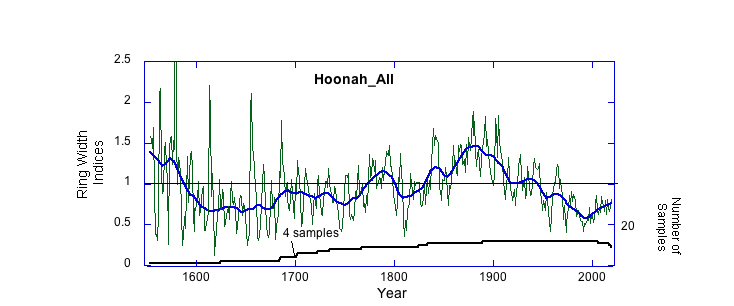 So we measured the ring-widths (Nick Wiesenberg and Melita Wiles did) and then we compiled the ring-width data into a chronology above. This chronology is the full record going back into the 16th century
So we measured the ring-widths (Nick Wiesenberg and Melita Wiles did) and then we compiled the ring-width data into a chronology above. This chronology is the full record going back into the 16th century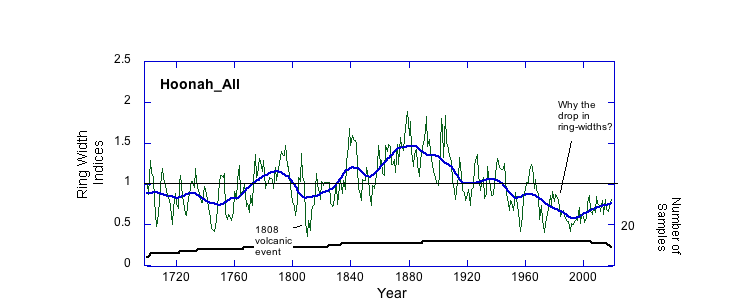 This chronology is truncated at 1720 or so when we had at least 4 samples. The most narrow rings follow the 1808 unknown eruption that cooled much of the region – it is unknown as no one knows where the volcano that erupted is located – it is recognized in ice cores. The other intriguing feature is the relatively recent (last 50 year) drop in ring widths. It may be due to increased evapotranspiration demands with increasing summer minimum temperatures. There is a correlation of -0.39 (p<0.04) between tree growth and average April-August minimum temperatures. Other studies have shown that warming night time temperatures lead to increased respiration at night and along with possible greater ET demand or increased cloudiness during the day there may be a decrease in photosynthesis leading to decreased carbon uptake (Sullivan et al., 2015). This is a promising line of research to further investigate the health of Mt. Hemlock in the region and it is something we plan to pursue with more samples in the future.
This chronology is truncated at 1720 or so when we had at least 4 samples. The most narrow rings follow the 1808 unknown eruption that cooled much of the region – it is unknown as no one knows where the volcano that erupted is located – it is recognized in ice cores. The other intriguing feature is the relatively recent (last 50 year) drop in ring widths. It may be due to increased evapotranspiration demands with increasing summer minimum temperatures. There is a correlation of -0.39 (p<0.04) between tree growth and average April-August minimum temperatures. Other studies have shown that warming night time temperatures lead to increased respiration at night and along with possible greater ET demand or increased cloudiness during the day there may be a decrease in photosynthesis leading to decreased carbon uptake (Sullivan et al., 2015). This is a promising line of research to further investigate the health of Mt. Hemlock in the region and it is something we plan to pursue with more samples in the future. 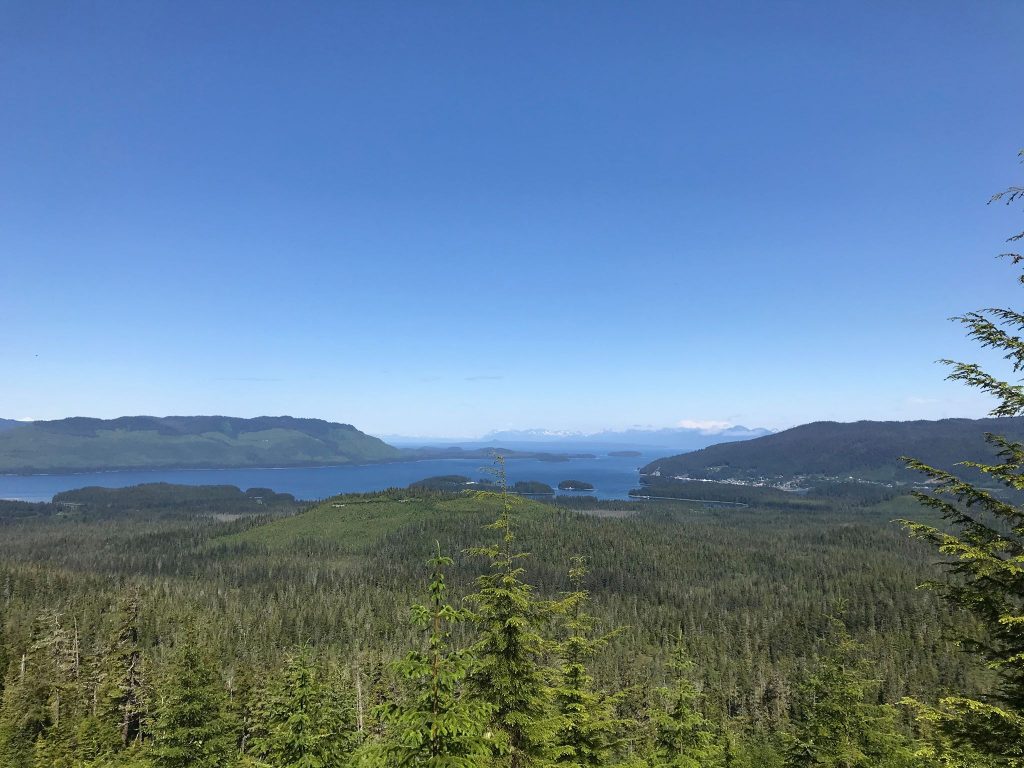 View from Ear Mountain looking north.
View from Ear Mountain looking north.

 The team coring a White Oak.
The team coring a White Oak. Measuring tree cores from Kinney Field in the Lab.
Measuring tree cores from Kinney Field in the Lab.




 Co-directors Nick Wiesenberg and Dr. Greg Wiles.
Co-directors Nick Wiesenberg and Dr. Greg Wiles.